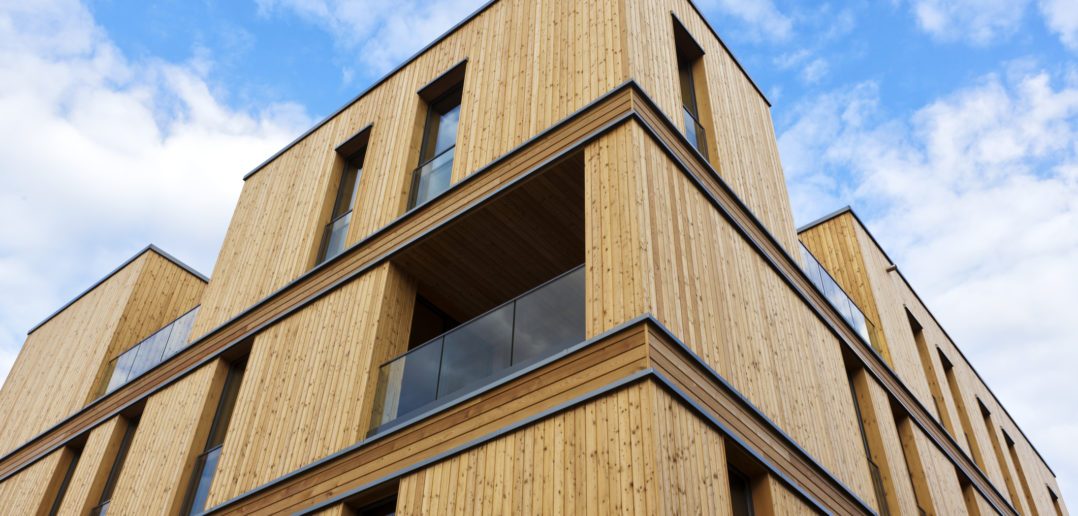Architects and builders looking to create unique, environmentally friendly structures have been turning to a new innovative wood material known as CLT. Cross-laminated timber (CLT) is a relatively new engineered wood product that is part of a broader category of products called “mass timber” and is proving to be a more sustainable product than traditional building materials of the last century like steel and concrete. Originally designed in Europe, construction using CLT is gaining momentum on a global scale.
CLT is a wood panel typically consisting of three, five, or seven layers of dimension lumber oriented at right angles to one another and then glued to form structural panels[i]. This layered structure provides dimensional stability and rigidity in two directions making it a viable alternative to steel and concrete.
A radical new approach to sustainable building
CLT was designed as a low-carbon alternative to heavy construction materials such as concrete and steel. These new, innovative ways of building with timber technology like CLT, significantly reduce the carbon footprint of a building in terms of both material production and on-site time and energy consumption. Unlike concrete and steel which generate a large amount of carbon dioxide during production, wood sequesters the carbon dioxide it absorbed during growth even after its been turned into lumber. The stored carbon mass of wood is significant and studies have shown that one cubic meter of wood will store one ton of carbon dioxide. [ii]
In addition to its environmental benefits, architects and builders are choosing to use wood for a variety of other reasons. CLT panels are prefabricated and shipped directly from the manufacturer to the job site, reducing the waste of materials and cutting back on construction time. In addition, CLT has proven to be cost effective in larger structures where fabrication is repetitive. This saving of time and materials results in significant costs savings, playing a major part of the rising popularity of this material.
Buildings built using CLT also offer operational and energy efficiencies. Because the panels are solid, there is little potential for airflow through the system creating an extremely tight building envelope. This airtight design creates thermal insulation. CLT’s highly thermal mass allows temperatures to remain stable and comfortable within the structure, significantly decreasing the need for heating or cooling.
Will CLT challenge the sustainability of forests?
Despite all of its benefits, building with wood still raises some concern. As these new wood materials continue to gain popularity, it is important to study the potential effect this rising demand could have on forests. If builders begin to replace steel and concrete with mass timber products such as CLT, will this create an unsustainable trend leading to deforestation? Current research and studies on forest growth-removal ratios show that deforestation will not be a concern because stringent sustainable forest management practices will restrict harvesting levels. Mass timber is also a renewable resource and as long as forests are maintained properly there will be an adequate supply of tress.
A new building landscape
CLT structures across the globe are gaining traction at a rapid rate. The first cross laminated timber high rise over 85 feet in the United States, called Framework, has just been approved. The building which will be built in Portland Oregon has a glulam post-and-beam structure, surrounding a CLT central core, and topped by CLT floor panels and gypsum concrete.
In London, PLP Architecture and Cambridge University’s Department of Architecture are proposing to build the cities first tall timber structure. The architecture firm believes that the transition to timber construction may have a wider positive impact on urban environments and built form, offering opportunities not only to rethink the aesthetics of buildings, but also the structural methodologies informing their design as well [iii]. The building would create 1,000 new residential units.
Thanks to the ecological and economical advantages of the practice, architects and builders will continue to push the envelope with new timber structures. With a number of new timber structures in the pipeline all over the world, wood has the potential to become a mainstream material for high-rise buildings, shaping our future skylines.
[i] Rethink Wood. (n.d.), Retrieved from https://www.rethinkwood.com/tall-wood-mass-timber/products/cross-laminated-timber-clt
[ii] Green, Michael (2013, February). Why we should build wooden skyscrapers. https://www.ted.com/talks/michael_green_why_we_should_build_wooden_skyscrapers
[iii] PLP/ Architecture (n.d.), Retrieved from https://www.plparchitecture.com/plp%2C-cambridge-university-and-smith-and-wallwork-present-timber-skyscraper-research-to-london’s-mayo.html
Top photo © eyewave/GettyImages



